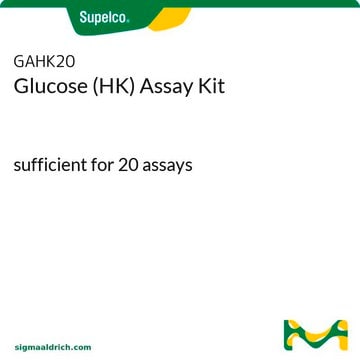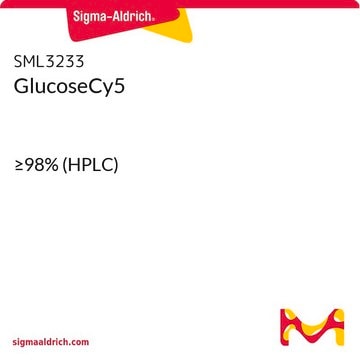MAK084
Glucose Uptake Fluorometric Assay Kit
sufficient for 100 fluorometric tests
Iniciar sesiónpara Ver la Fijación de precios por contrato y de la organización
About This Item
UNSPSC Code:
12161503
NACRES:
NA.84
Productos recomendados
usage
sufficient for 100 fluorometric tests
detection method
fluorometric
relevant disease(s)
endocrinological disorders, diabetes; cancer
storage temp.
−20°C
General description
The new Glucose Uptake Assay Kit, MAK489, is now available! Glucose is the primary source of energy for most cells.Transport of glucose across the plasma membrane is the first rate limiting step in glucose metabolism. Glucose uptake is facilitated by the GLUT family of transporter proteins, whose expression and activity are regulated by multiple mechanisms. Glucose uptake is upregulated in many cancer cells, which exhibit high rates of aerobic glycolysis. Cells exhibiting insulin resistance show diminished glucose uptake in response to insulin stimulation.
Application
Glucose Uptake Fluorometric Assay Kit has been used to measure the amount of glucose uptake by monocytic myeloid-derived suppressor cells (M-MDSCs).
Suitability
Suitable for detecting glucose uptake in adherent or suspension cells cultured in a 96-well microtiter plate.
Principle
The Glucose Uptake Fluorometric Assay kit provides a simple and direct procedure for measuring glucose uptake in a variety of cells. Glucose uptake is measured using the glucose analog, 2-deoxyglucose (2-DG), which is taken up by cells and phosphorylated by hexokinase to 2-DG6P. 2-DG6P cannot be further metabolized and accumulates in cells, directly proportional to the glucose uptake by cells. In this assay, 2-DG uptake is determined by a coupled enzymatic assay in which the 2-DG6P is oxidized, resulting in the generation of NADPH, which reacts with the probe to generate a fluorometric (λex = 535/λem = 587 nm) product, proportional to the 2-DG taken up by the cell.
related product
Referencia del producto
Descripción
Precios
replaced by
Referencia del producto
Descripción
Precios
hcodes
pcodes
Hazard Classifications
Aquatic Chronic 3
Storage Class
10 - Combustible liquids
flash_point_f
188.6 °F - closed cup
flash_point_c
87 °C - closed cup
Certificados de análisis (COA)
Busque Certificados de análisis (COA) introduciendo el número de lote del producto. Los números de lote se encuentran en la etiqueta del producto después de las palabras «Lot» o «Batch»
¿Ya tiene este producto?
Encuentre la documentación para los productos que ha comprado recientemente en la Biblioteca de documentos.
Yang Zhao et al.
Blood, 131(14), 1587-1599 (2018-02-22)
Monocytes and macrophages play a key role in defending pathogens, removing the dead cells or cell debris, and wound healing. The mammalian target of rapamycin (mTOR) inhibitor rapamycin (RPM) is widely used in clinics to treat patients with organ transplantation
Chapter Twenty-Two Mechanisms and Methods in Glucose Metabolism and Cell Death.
Zhao Y, et al.
Methods in Enzymology, 442, 439-457 (2008)
Norio Yamamoto et al.
Current protocols in pharmacology, Chapter 12, Unit 12-Unit 12 (2011-12-08)
Facilitative glucose uptake transport systems are ubiquitous in animal cells and responsible for transporting glucose across the cell surface membrane. Evaluation of glucose uptake is crucial in the study of numerous diseases and metabolic disorders, such as myocardial ischemia, diabetes
Norio Yamamoto et al.
Analytical biochemistry, 404(2), 238-240 (2010-05-25)
Previously, we developed a microplate assay to quantitate 2-deoxyglucose (2DG) and 2-deoxyglucose-6-phosphate in samples for in vitro and in vivo use. In this assay system, four different reaction mixtures were used, and the difference in the reactivity of the two
Norio Yamamoto et al.
Analytical biochemistry, 375(2), 397-399 (2008-02-12)
To determine 2-deoxy-D-glucose (2DG) and 2-deoxy-D-glucose 6-phosphate (DG6P) in mouse tissue after injection of 2DG, we have developed a novel assay. This assay is a simple procedure involving incubation of samples with four independent, single reaction mixtures followed by measurement
Nuestro equipo de científicos tiene experiencia en todas las áreas de investigación: Ciencias de la vida, Ciencia de los materiales, Síntesis química, Cromatografía, Analítica y muchas otras.
Póngase en contacto con el Servicio técnico

![2-Deoxy-2-[(7-nitro-2,1,3-benzoxadiazol-4-yl)amino]-D-glucose ≥97% (HPLC)](/deepweb/assets/sigmaaldrich/product/structures/104/527/40bd5a41-ebc4-484e-a10e-891fecfaea79/640/40bd5a41-ebc4-484e-a10e-891fecfaea79.png)

